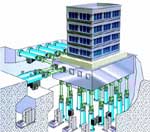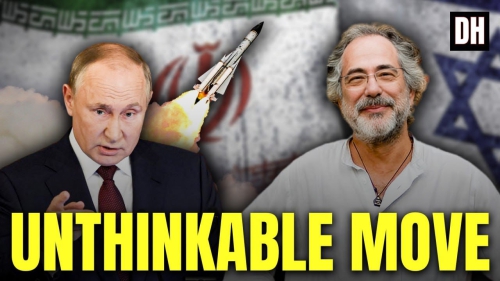Time to reflect on the earthquake tragedy in Iran
 |
|
Conceptual diagram of a Earthquake Testing Facility |
The Iranian and U.S. seismologists measured the earthquake, which struck Bam, Iran (pop. 110,000) during the early hours of December 26, 2003 to be 6.6 on the Richter scale. It inflicted massive destruction in Bam, and judging by the numbers it is a great tragedy resulting in more than 50,000 dead, thousands injured, still many thousands homeless, or widowed or orphaned, and 90% of the buildings razed to the ground, including the two major hospitals. One shudders at the magnitude of the destruction, and even the hardest of hearts have become malleable. And we say: "to God we all belong and to Him is our return".
One of the survivors of the Bam earthquake, an 80-year old woman, who had lost 16 members of her family, in her hour of grief and suffering said: "it is a test from God". Indeed all calamities are a test, not only for those who suffered, but also those around them, as to how they managed the calamity and its aftermath.
To draw a comparison with the Bam earthquake; look at a comparable quake of 6.5 magnitude hitting Paso Robles, California (pop. 24,000) on December 22, 2003, with only two deaths, 40 injured, and only few buildings collapsed. Yet another similar earthquake, 6.6 on Richter scale, occurred in Taitung (pop. 117,000), near Taipei, Taiwan on December 10, 2003, with no deaths and no reported building collapses.
The large variation in the number of dead in the three quakes is quite an eye-opener, and actually is particularly instructive. Why is it that on 6.6M more than 50,000-died in Bam, Iran and why only two in the Paso Robles, U.S. and none in Taitung, Taiwan? One can have a fatalistic attitude and say it was God's Will, true, it was God's Will, and it always is, and one should repose one's trust in Him. However, amiss is the fact that, that the developing world has not done enough to value human life. At this juncture one is reminded of a man who came to visit Prophet Muhammad (peace be upon him) and said "I will not tie my camel and trust (tawakal) Allah", Prophet Muhammad (peace be upon him) said " tie it and trust (tawakal) Allah" (Tirmidhi). In this case tying the camel was the right thing to do, in order for it not to stray into the desert. However, this does not mean that our trust in God is based on tying the camel. Trust has to be absolute and regardless of our actions, but logical actions have to precede. We are reminded in the Qur'an that "..surely Allah does not change the condition of the people, until they change themselves.." (Ar-Rad 13:11).
This leads me to my point that much-needed building codes have been lacking in developing countries in the region, more so in areas prone to natural calamities such as earthquakes, floods, hurricanes, or lightening strikes. Even when the building codes are on the books, they are not implemented due to either greed on the part of the contractor, or the owner, or incompetent and corrupt building inspectors. A saying among some seismologists is that: "earthquakes don't kill people, buildings kill people." Therefore, the primary obligation for crafting and strict implementation of building codes is on local, provincial, and central governments. Obviously, any loss of life in a similar tragedy, when knowing specifically that the area is in a tectonically active region, and that there have been previous earthquakes in the same region causing considerable destruction, it is the head of the government who is to be held accountable both in this world and hereafter. No wonder leading a nation is no small task and comes with a heavy responsibility.
Among some of the recent strong (6-6.9M) and major (7-7.9M) earthquakes recorded on the Richter scale in the region, causing large number of deaths and destruction documented by the U.S. Geological Survey and other credible sources include: 1) January 26, 2001 in Bhuj-Ahmadabad-Rajkot- Gujarat, India, 7.9 magnitude, killed more than 20,000, displaced 500,000, destroyed 339,000 and damaged 783,000 buildings; 2) August 17, 1999 in Turkey-Kocaeli (Izmit) (pop. 196,000), 7.6 magnitude, broke a section of the North Anatolian Fault 1,500 km to the west of this quake and killed 17,000 people, injured 50,0000, and left 500,000 homeless; 3) March 25, 2002 in Baghlan province (pop. 42,000), Afghanistan, 6.1magnitude, caused 1000 deaths and 1500 houses were razed to the ground by resulting landslides; 4) December 28, 1974 in Malakand District (443,000 pop.), NWFP, Pakistan; 6.2 magnitude destroyed villages over 250 square km in the Karakoram mountains; killed 5,200 dead and injured over 16,000; and 5) June 20, 1990 in Rasht-Qazvin-Zanjan, Iran; 7.4 magnitude, over 40,000 killed and 60,000 injured, and made 400,000 homeless; and in Rudbar-Manjil area nearly all buildings were destroyed.
Granted there are other factors including population density or degree of isolation, intensity and duration of the earthquake, soil type, and economic condition of the affected region, which determine the magnitude of the loss of life and property damage. However, when comparing these earthquakes with those in the developed world and even Taiwan, the huge disparity in the scale of death and destruction is thought provoking.
After having carefully crafted and honestly implemented building codes and having taken all other logical measures, if then a natural calamity strikes and leads to destruction, then one can turn around and say it was God's Will, as we did all we could to minimize death and destruction.
What lessons the governments and people of the region learn from the tragedy, and how they prepare themselves for such an eventuality in future is an open question. If pass records are any indication, then it may be business as usual, until the next one. This approach will be inexcusable.
God forbid before another earthquake strikes, it will be prudent for the governments of Afghanistan, Iran, Pakistan, and Turkey, and other countries in the region who may have similar concerns to join hands in connecting their existing earthquake centers by setting up a regional Earthquake Monitoring Research and Development Center and a Disaster Relief Center (for earthquake prediction, prevention or minimization of building damage, and disaster relief). At this juncture, it may seem to be a huge undertaking or some may consider it to be frivolous; but mind you one earthquake, can take us all back to square one. Therefore, the camel needs to be tied.
Irfan S. Ahmad is a research scientist and an entrepreneur in the US. He can be reached at: [email protected]
Our prayers go out for the men, women and children of Iran who face the perils of the massive earthquake that has devastated the historic south-eastern fort city of Bam.
Despite massive international relief efforts, aid workers say more is needed to help an estimated 100,000 people left homeless and thousands more injured in the quake.
IslamiCity through it's parent organization HADI (Human Assistance & Development International) has established an Iran Relief Fund. In cooperation with trusted NGO's on the field, this fund will provide assistance to the survivors and respond to various humanitarian needs.
Your support is urgently needed!!!
Click HERE to donate
O ye who believe! seek help with patient perseverance and prayer; for Allah is with those who patiently persevere. Quran 2:153
Topics: California, Iran, Nature And Environment
Views: 5747
Related Suggestions
Salaam Alikum
Teklis Sesemar
http://web2.dk/Earthquake_Bam_Iran.htm
With deepest sorrow,
Kiumars
www.web2.dk
http://www.moroccousa.com/articles/weeklyresource.cfm?ID=49
Thank you.
The author of the article expressed the exact sentiments I had felt after learning about the tragic news. (Thank you Brother, for such a well-written article). For how long shall we continue to endure such tragedies, and remain indifferent or fatalistic, leaving everything to the will of God? Allah (swt) has blessed us with such brainpower that we can achieve anything that we can conceive--if so pleases Him. And surely, Heloves us and wants only the best for us; and He has given us means to prevent such horrors: if people in USA & Taiwan can prevent them, what is wrong with the rest of the world? Allah (swt) is Most Just and Merciful: We have to realize He did not create any one group of people to be better than others. As the author of the article said, the main question is, what can we learn from this 'test' send down to us from God? In the words of Napoleon Hill: In every adversity there is a seed of equal or greater opportunity, and Allah (swt) Himself says in the Holy Quran [13:12]: "It is He Who does show you the lightning, by way both of fear and of hope: It is He Who does raise up the clouds, heavy with (fertilising) rain!" Lighning has struct us, and may we take the lesson of "hope" to prevent future tragedies. Surely, if so pleases Him, Allah (swt) will guide us all towards that what is best.
May Allah (swt) forgive the deceased, and guide the living: My prayers go out to everyone who has been affected by the earthquake in Iran.

















